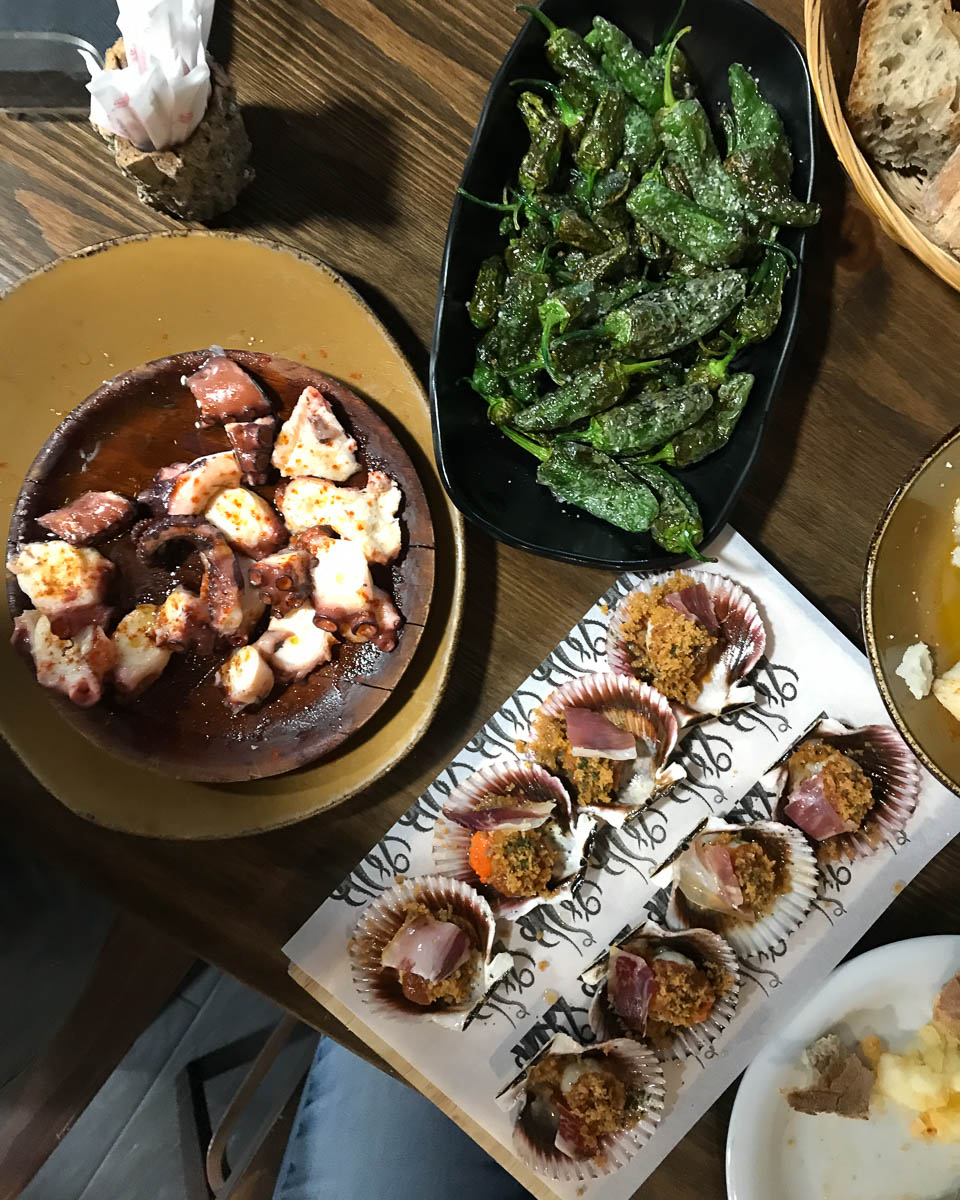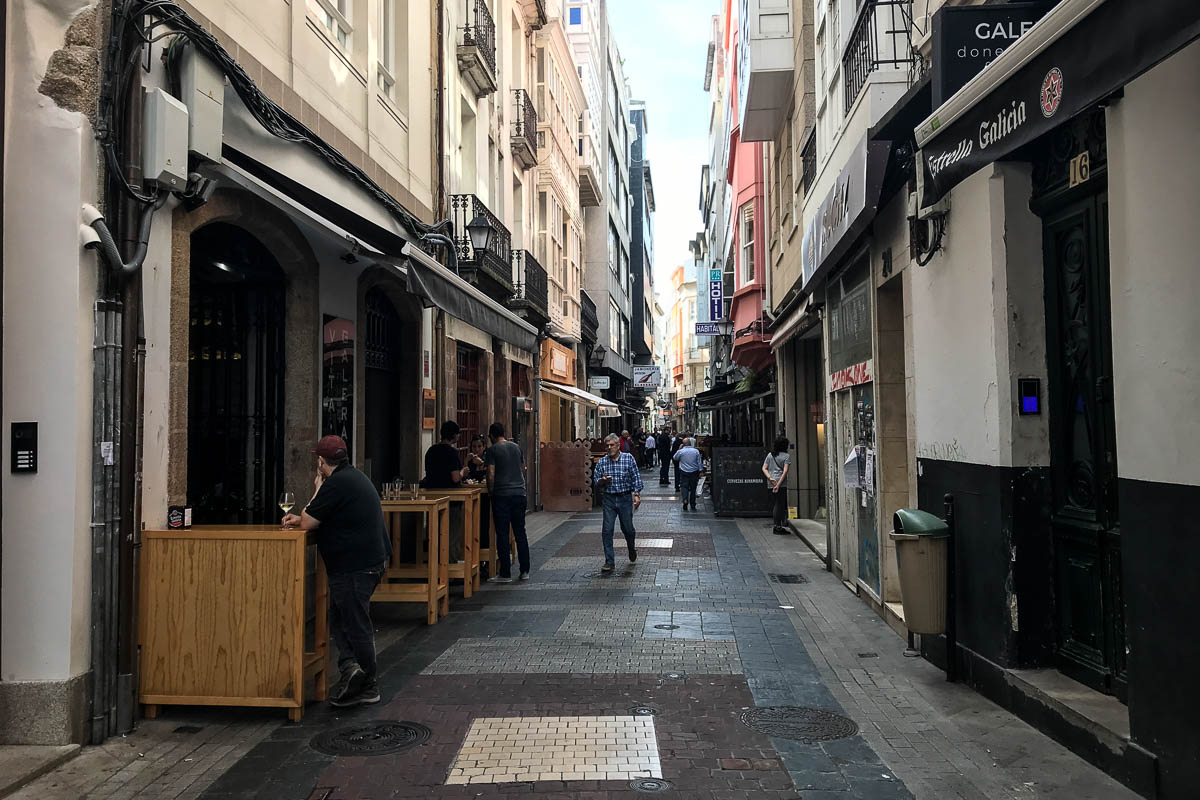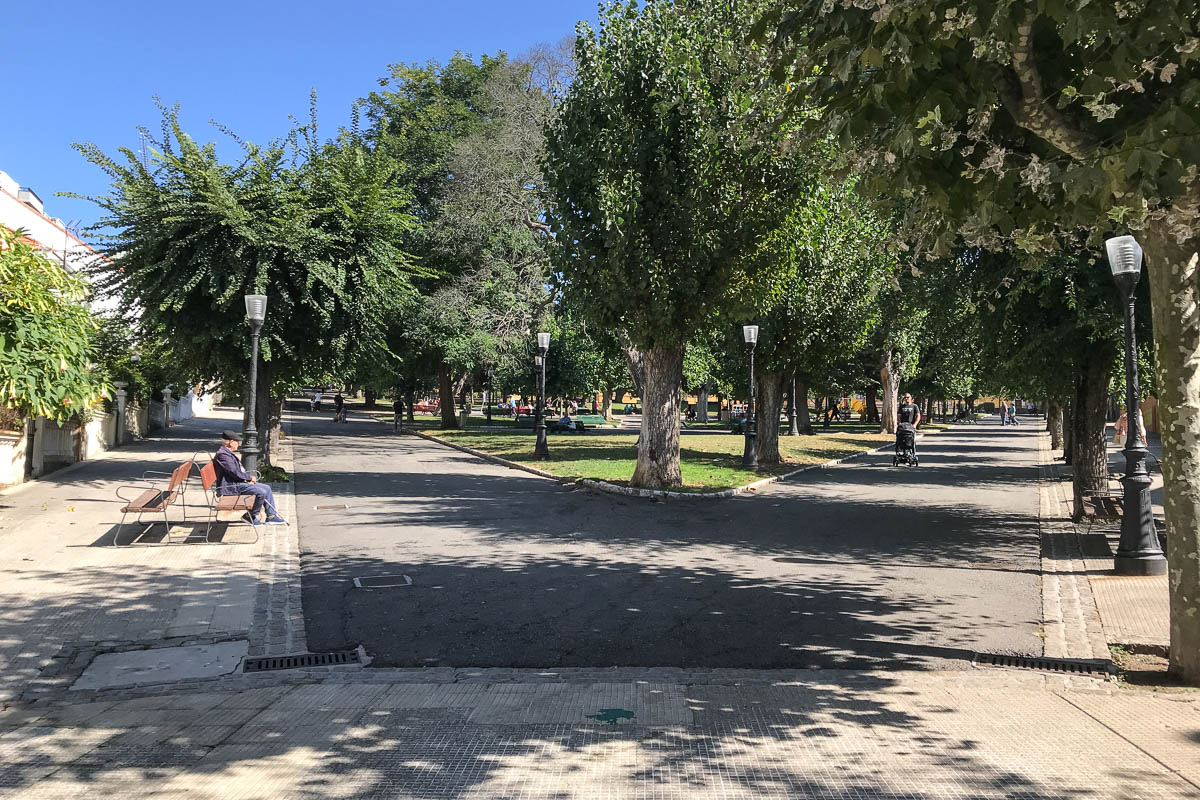For Ian, A Coruña was a reminder of San Francisco, his favorite US city, but without the high prices. For Ann, it was the fear associated with leaning out the 6th floor window to hang the laundry. 
And for both, it was a clear water beach, yummy bread, empanadas, tapas and pinchos, and good local Spanish wine. All relatively inexpensive, we spent a total of $677 for eight days.
For both, it was a surprise favorite destination that was only added because we spotted a cheap airfare from Las Palmas that got us to Spain’s northern coast where we wanted to be.
On Spain’s northwest coast, A Coruña, also referred to as La Coruña and simply Coruña by the locals, has a population of about 245,000. It is the capital city of the province, A Coruña, which is in the autonomous community of Galicia. Spain has 50 provinces and 17 autonomous communities. This system means that people in a city vote for local, provincial, and autonomous community government officials.

Las Palmas, Gran Canaria to A Coruña
We flew on Vueling, a Spanish low-cost airline with mostly negative reviews for 120 € each, which included paying for all the Priority extras, like we did here and here. Overall, we had a pleasant experience on the 3-hour flight. That’s four budget European airlines that we’ve flown during these five months with no complaints.
Arrival in A Coruña
We took a bus from the airport for 1.65 € each, just pay the bus driver when you board. It was a pleasant 30-minute ride to the Porta Real stop, a picturesque harbor in the center of town.

From there, we walked about 25 minutes through the main square, Plaza de Maria Pita, and then uphill to our apartment. We both had positive first impressions, except maybe for Ann’s comment that she wasn’t expecting the hills. Perhaps because she was anticipating the climb to our 5th floor (6th in US lingo) walk-up apartment.
Plaza de Maria Pita
A Coruña’s main square, Plaza de Maria Pita, was named for a heroic woman instrumental in minimizing losses when Sir Francis Drake attacked the city in 1589. The Palacio Municipal (Town Hall and Council Building) dominates the large square. Although its appearance suggests it’s older, this impressive building, with its three domed towers, was built in the early twentieth century. The plaza includes a statue of its namesake and is surrounded by large buildings, plus several restaurants and bars.

Walking through the square, we passed the edge of the old town center before heading uphill to our apartment.
Food and Drink in A Coruña
Pulpo á feira is one the signature dishes of Galicia. It is boiled octopus with sweet and/or hot paprika and olive oil. Served with cachelos, chunks of potatoes also with olive oil and paprika. We tried this local favorite at Pulpeira de Melide .

Yes, even Ian (who has texture issues) ate this as it was quite tender. Another popular local dish is tortilla Española, which is a kind of egg and potato pie.
In restaurants, you can order a ración, or shared plate. One which we tried in several cities throughout Spain is gambas a la plancha, grilled shrimp in olive oil and sea salt. Sometimes the shrimp are served whole and unpeeled, which makes for messy eating.
Tapas and Pinchos
We found one street, Rua Galera , in the pedestrian zone in the old center of town, with several tapa bars and pincho bars.

The rules as to how tapas bars work vary somewhat from one city the next throughout Spain. In A Coruña, tapas are usually simpler food like tortilla Española, and cost about 2 € each. A glass of local wine or beer at a tapas bar was also about 2 €. We can recommend Bar La Bombilla, for an old school experience, and Vitak, for a more modern take.

Thanks to Craig and Linda of Indie Travel Podcast for the recommendations.
Pinchos, on the other hand, are a bit fancier and with more choices. These eye-appealing delights are displayed in cases along the bar. They consist of a small piece of French bread toast with a variety of toppings, usually more than one topping on each. In A Coruña, we saw (and tasted!) several. Pinchos came with a variety of seafood and grilled meat, prepared in different ways, and most averaged about 3 €.

The busy times in tapas bars here start around 2 pm and again at about 9 pm. We chose the lunchtime experience, arriving 1-1:30 pm to avoid the crowds. Then after we had our fill, we could observe the hubbub without having to put on battle gear to get served.
Wine and Beer in A Coruña
We tended to go local in A Coruña, which included choosing the local wine. The white Albariño reminded us of Pinot Grigio, and the light, red Mencia reminded us of Grenache. The local beer, Estrela Galicia, is ubiquitous. While it’s not a craft brew, a unique aspect was that in most bars, it was brewed on site.
A Coruña Beaches
The main beaches in A Coruña are Praia de Riazor and Praia do Orzán (in Galician language). They pretty much form one long curved beach separated by a headland from the main shipping port and marina. The beach is slopy with coarse sand, so not great for walking. The water is clear, a bit cooler than in Las Palmas, and the tide can come in rather suddenly. We saw more than a few sunbathers get caught unawares. Despite this observation, we almost got caught ourselves a few days later.

At the northeastern end of these beaches is the much smaller Praia do Matadouro, our favorite spot, with finer sand, less slope, and even clearer, calmer water. Not to mention it was closest to our apartment. Although this small piece of beach can get rather crowded, especially around 5 o’clock on a weekday.


Millennium Obelisk
Since we couldn’t comfortably walk the beach, we just had to settle for walking along the promenade above the beach, which had amazing views. The promenade has both walking and biking paths. Along the way, we happened upon the Millennium Obelisk, constructed to celebrate the beginning of the 21st century. This impressive and colorful monument is 50 meters tall and is composed of 2 tons of steel and 147 blue and green rock crystals from Holland. Its various panels tell the history of A Coruña.

Tower of Hercules
We set aside a day to visit the Tower of Hercules. Besides being an iconic sight in A Coruña, when do you get to visit a lighthouse from Roman times?! As we walked towards the tower, we noticed that the further we got from the center of town, we saw newer and taller apartment buildings.

The Tower of Hercules sits on a peninsula about 2.4 km (1.5 mi) outside the center of town. The original tower dates from the 2nd century (or possibly earlier) and is thought to be the oldest continually operating lighthouse. Between 1788 and 1791, a neoclassical style tower was built around the outside of the original tower to protect it from the elements. This new construction added a 4th floor, adding 21 m (69 ft) to the original 34 m (112 ft).

Inside the tower, it was fascinating to see the original Roman structure while climbing the 234 steps to the top. Well worth it! Not to mention the amazing, extremely windy view at the top!

We could see extensive dirt paths along the sea below, perhaps for hiking another day.

Our Daily Life in A Coruña
Our large, comfortable, 2 BR, 2½ BA apartment in the residential Montealto neighborhood cost us $55 per night including all fees. (We had such a large apartment for just the two of us because it was the best deal on Airbnb that met our preferences.) The apartment was about a 15-20 minute walk to the center of town and 5 minutes to the beach. We tried to limit our going out to once a day due to the 82 steps we had to climb to the top floor of our building. As with many other older apartment buildings (see here and here and here to name a few.) throughout Europe, this one didn’t have an elevator.
Our daily outings included a variety of activities. We would walk the two blocks to the Mercado municipal and adjacent large supermarket. Another day, we might walk into town for lunch at a tapa or pincho bar. On our way, we passed through the neighborhood park, always filled with people and activity.

Parents with children, people walking their dogs, and people (usually more elderly) sitting on benches chatting or just watching the world go by. Or… (you guessed it!) we would go to the beach.
Some days we just wandered and explored. Most days included a visit to a local bakery for fresh bread and possibly a section of empanada, which is baked as one full-size pie.

Plus, a visit to our friendly local convenience store to pick up a bottle of local wine for 2 €. These delicious wines came from small wine makers; the bottles didn’t even have labels.
Some Minor Oddities
The whole time, we never figured out for sure which of the different color trash bins on the street were for what kind of trash. Plus, Ann kept noticing green frogs painted on the sidewalks in our neighborhood. She forgot to inquire of the locals while we were there and couldn’t find an explanation on the Internet. If anyone knows the significance, please let us know. Otherwise, these frogs will remain a mystery, at least until a return visit to A Coruña.

A Coruña Wrap-Up – Why We Liked It There
As mentioned earlier, A Coruña reminded Ian of San Francisco. The sound of seagulls, the fog rolling in, and the buildings in our neighborhood were like those in San Francisco’s Sunset District. We both liked the overall vibe of the city. Neighborhood parks and friendly, helpful locals, especially when we tried to talk to them in Spanish. Not a lot of English is spoken here, as we’ve found to be the case in most places we’ve visited in Spain, except in tourist areas. We found A Coruña to be relatively uncrowded, even in the town center, except on weekends. Oh, and did we mention the food and bread and wine and tapas and pinchos? Plus of course, there’s the beach!

Next Up: Moving east on the north coast of Spain to Santander
Ian & Ann

6 Comments
Hi Ian and Ann, thanks for the mention! Glad to see you had such a good time in Coruña, one of my favourite places. 🙂 Craig and I were talking about those frogs last time we were there, and we *think* they may direct people to a daycare centre. Not sure though!
Hi Linda,
Coruña is one of our favorite places too. Thanks for the info about the frogs – that would explain why I couldn’t find anything on the Internet. Whoever gets back to Coruña first will just have to follow the frogs to find out for sure. 🙂
Ian & Ann
Another wonderful travel log! Thank you so much.
Thanks, Karen, so glad you are enjoying our posts.
Ian & Ann
HI Ian & Ann,
Enjoyed your blog and all the amazing pics. Think I’ll put that on my bucket list.
Wishing you a great holiday!
Hi Marge,
Yes, we can definitely recommend A Coruña, and at some point we might go back for a longer stay.
Happy Holidays to you too!
Ian & Ann